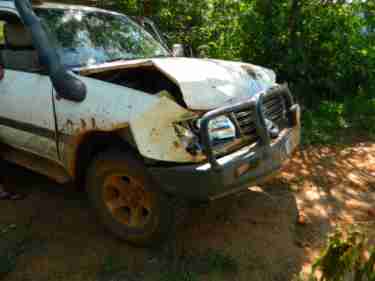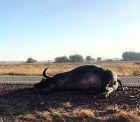

Animals on The Road!
The chance of a large animal encounter increases the more time we spend on the road and even more so when we extend that driving time into the night or begin our journey prior to sunrise. Even though the range of LED driving lights that are now available and the illumination they provide is significantly better than ever, this is not the only factor in this situation. Often the way the animals behave or react can the problem.
Vehicle noise as in those created by the bull bar or the roof rack or the tyres on the road surface can spook animals and cause them to react or suddenly run. Instincts such as following the “herd” as such, means that all the cattle may dutifully follow the leader across the road. The bright lights that help us to see can also both spook the animals causing them to flee or alternatively to stay still (caught in the headlights as such), either way this can be a problem for us and the animal.

The habit of kangaroos and wallaby to change their mind just when you think they are clear of the road is both dangerous for us and often fatal for the animals. If the track you are on is a narrow one with thick grasses on the sides, then the chance of something jumping out at you is very high. This is exactly what happened in the above situation. It was at night, a very narrow track with lots of shrubs and grasses and also a sense of urgency as there was a child that had sustained an injury on board and then of course there was the old bull. The picture tells the story, unfortunately the bull didn’t survive and the car was no longer drivable.
Apart from all the behaviours that the wildlife can demonstrate, we are also a factor in this situation. Are you tired, how long have you been driving, what is my reaction time, how fast am I traveling, am I on dirt or the bitumen and what is the condition of our car. All of these factors can determine the outcome of this situation. Check out driving courses
The safest thing to do is hit the brakes and keep the steering wheel straight. The worst thing for us to do as our first reaction is to swerve. Often this results in a vehicle rollover and severe injury to the occupants. On our training courses we aim to instil in our drivers that they do not swerve, but brake hard, keep the wheels straight and rapidly try and assess the situation. We actually practice this and further suggest that each individual undertake this exercise every 3 months or so when they are out at a suitable area.
The ensuing outcome will depend on the drivers experience, travel speed, road conditions, vehicle type and the driver’s reaction time. We hope that through keeping the vehicle straight, braking hard (emergency braking situation) and with any luck the animal/s will continue on before we get to them. Remember, do not swerve as your first reaction! Look at 4WD training in Darwin